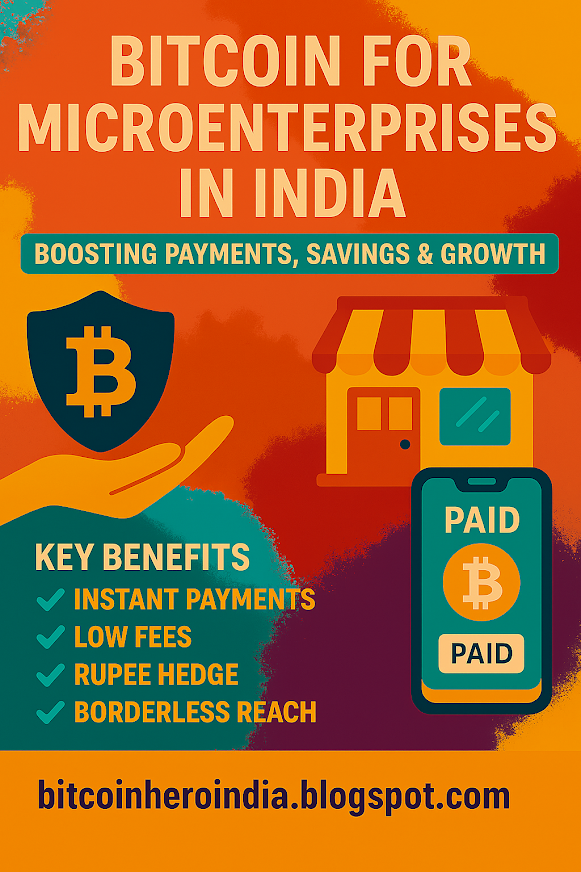🏪 Bitcoin for Microenterprises in India: Boosting Payments, Savings & Growth
India’s microenterprises—from street-food vendors in Delhi to handicraft cooperatives in Odisha—drive local economies but often face cash flow challenges, high transaction fees, and limited banking access. Bitcoin offers a permissionless, low-fee payment rail, combined with self-custody for savings and borderless access to customers and suppliers. In this 1,200+ word guide, we’ll show you how small businesses can integrate Bitcoin to streamline payments, hedge rupee volatility, and unlock new growth channels.
Table of Contents
- 1. Why Bitcoin for Microenterprises?
- 2. Real-World Case Studies
- 3. Getting Started: Tools & Workflows
- 4. UX & Mobile-Friendly Best Practices
- 5. Tax & Regulatory Considerations
- 6. Challenges & Mitigation Strategies
- 7. Future Growth Opportunities
- 8. Newsletter & Community
- 9. Disclaimer
1. Why Bitcoin for Microenterprises?
Microenterprises in India often rely on cash transactions or UPI, exposing them to theft, daily collection limits, and fee structures that eat into thin margins. Bitcoin introduces:
- Instant Settlement: Lightning payments clear in seconds—no waiting days for bank settlements.
- Minimal Fees: On-chain fees of ₹20-₹200; Lightning micropayments under ₹1, ideal for low-ticket sales.
- Self-Custody Savings: Retain earnings in sats to hedge against rupee inflation and access global liquidity.
- Borderless Commerce: Receive payments from tourists and exporters without currency conversions or wire-transfer delays.
By embracing Bitcoin, shopkeepers can reduce overhead, protect purchasing power, and appeal to tech-savvy customers.
2. Real-World Case Studies
| Business | Location | Use Case | Outcome |
|---|---|---|---|
| Chaiwala Corner | Chandigarh | Lightning tea payments | Reduced cash handling; 15% uptick in foot traffic from crypto enthusiasts. |
| Sathi Handicrafts | Jaipur | On-chain BTC for export orders | Faster payments, zero FX fees, 20% higher profit margins. |
| Maths Tuition Center | Lucknow | Monthly sats subscriptions | Steady cash flow; parents appreciated auto-renewal via LNURL-sub. |
3. Getting Started: Tools & Workflows
- Choose a Wallet or POS App - Lightning-enabled: Phoenix, Breez, Muun for instant payments. - On-chain only: BlueWallet or Bitcoin Core SPV.
-
Set Up Payment Interfaces
- QR Code Display: Print a static Lightning invoice QR for common prices (e.g., ₹20, ₹50).
- Dynamic Invoices: Use BTCPay Server or OpenNode widget to generate invoices per sale.
Image Alt Text: A shopkeeper’s counter displaying Lightning QR codes. - Integrate with Existing Systems - Excel/Google Sheets: Log transactions with timestamp, invoice ID, and INR equivalent. - Local Accounting Software: Use CoinTrac or a custom spreadsheet for tax-ready reports.
- Train Staff - Conduct a 30-minute demo on scanning QR codes, invoice expiry, and refunds. - Provide a printed workflow cheat sheet in local language.
- Promote to Customers - Display “Accepting Bitcoin” stickers and social media posts. - Offer a small discount (2–3%) for BTC payments to incentivize usage.
4. UX & Mobile-Friendly Best Practices
- Use large, high-contrast QR codes (minimum 250×250px) for easy scanning on low-resolution phones.
- Keep the payment flow under 3 taps: open wallet → scan → confirm.
- Display an automatic success screen with sats paid and INR value for customer reassurance.
- Provide “Copy Invoice” and “Refresh QR” buttons for users with connectivity issues.
- Design for dual-language labels (English + local) to improve accessibility.
5. Tax & Regulatory Considerations
- 1% TDS: Applies on crypto remittance above ₹10,000 per transaction. Maintain logs of senders and receivers.
- 30% Tax: Capital gains on BTC held and converted to INR. Track cost basis and sale price per transaction.
- GST Treatment: BTC payments for goods/services attract regular GST rates; treat sats as payment rail, not supply.
- KYC/AML: Exchanges and high-value wallets require customer KYC; document any large incoming payments for audit.
6. Challenges & Mitigation Strategies
| Challenge | Mitigation |
|---|---|
| Price Volatility | Auto-convert sats to INR daily via P2P exchange or custodial on-ramp. |
| Invoice Expiry | Set QR expiration to 30 minutes and display countdown timer. |
| Digital Literacy | Use icon-based instructions and local-language training videos. |
| Connectivity Outages | Offer manual invoice numbers with fallback UPI payment instructions. |
7. Future Growth Opportunities
As adoption grows:
- Loyalty Programs: Issue sats-back rewards on repeat purchases via Lightning invoices.
- Supplier Payments: Settle inventory suppliers in sats to negotiate better terms and faster procurement.
- Community Markets: Local bazaars can host pooled Lightning nodes for shared liquidity and micro-grid integration.
- Integration with CBDC: Future hybrids combining Digital Rupee for compliance and Bitcoin rails for speed and cost.
Related Guides
Categories/Labels: Bitcoin, Microenterprise, MSME, Payments, India, Lightning Network
9. Disclaimer
This article is for educational purposes only and does not constitute financial, legal, or tax advice. Always perform your own due diligence and consult qualified professionals before accepting or converting Bitcoin in your business.
```






0 Comments